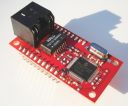Differences
This shows you the differences between two versions of the page.
| Both sides previous revision Previous revision Next revision | Previous revision Next revision Both sides next revision | ||
|
en:netzer:boot2 [2012/01/02 11:42] svesch [Bootloader Version 2] |
en:netzer:boot2 [2012/07/30 09:56] svesch [Updates in operation mode] curl added |
||
|---|---|---|---|
| Line 14: | Line 14: | ||
| <WRAP center round download 60%> | <WRAP center round download 60%> | ||
| + | * {{:bins:120309_netzer.tar.gz|Version 1.4 base Build 222 (Release 2012-03-09)}} | ||
| * {{:bins:120102_netzer.tar.gz|Version 1.4 base Build 220 (Release 2012-01-02)}} | * {{:bins:120102_netzer.tar.gz|Version 1.4 base Build 220 (Release 2012-01-02)}} | ||
| * {{:bins:111223_netzer.tar.gz|Version 1.4 base Build 219 (Release 2011-12-23)}} | * {{:bins:111223_netzer.tar.gz|Version 1.4 base Build 219 (Release 2011-12-23)}} | ||
| Line 31: | Line 32: | ||
| ===== Updates in operation mode ===== | ===== Updates in operation mode ===== | ||
| - | The update is done with a PC via the network. The hex file should be stored to hard disk before. The file is transfered to the Networker via tftp. For the update therefore a tftp client is needed. At the most operating systems such a client is included. | + | The update is done with a PC via the network. The hex file should be stored to hard disk before. The file is transfered to the Netzer via tftp. For the update therefore a tftp client is needed. At the most operating systems such a client is included. |
| - | Since Version 1.3 the Firmware update has to be explicitly activated via the Networker web interface (logged in as administrator). This eliminates a potential security risk of Networker. In the common settings a radio group can be found: | + | Since Version 1.3 the Firmware update has to be explicitly activated via the Netzer web interface (logged in as administrator). This eliminates a potential security risk of Netzer. In the common settings a radio group can be found: |
| {{ webinterface_permit_firmware_upload.jpg?nolink& |Webinterface screenshot}} | {{ webinterface_permit_firmware_upload.jpg?nolink& |Webinterface screenshot}} | ||
| - | The file is transfered to Networker with the TFTP PUT command. Networker is accessed via the current IP address or the network name. Example for a tftp command in a shell box under Windows: | + | There is also the possibility to activate the Firmware uploads from command line with **curl**: |
| + | <code>curl --data "ubf=1&O=Save" http://user:password@netzer_name.local/common.htm</code> | ||
| + | //netzer_name// must be the MDNS name of Netzer. Fill in administrator accounts data for //user// and //password//. Installed firmware without access control can simply use the following command: | ||
| + | <code>curl --data "ubf=1&O=Save" http://ne2c3519.local/common.htm</code> | ||
| + | |||
| + | |||
| + | The file is transfered to Netzer with the TFTP PUT command. Networker is accessed via the current IP address or the network name. Example for a tftp command in a shell box under Windows: | ||
| <code>tftp ne7C4000.local put "Netzer.hex"</code> | <code>tftp ne7C4000.local put "Netzer.hex"</code> | ||
| - | Networker goes into the update mode automatically and the file is transfered. A running transfer is indicated through the network activity LED, which is emitting for about 20 seconds. After the transfer has finished successfully the tftp client prints out that message: | + | Netzer goes into the update mode automatically and the file is transfered. A running transfer is indicated through the network activity LED, which is emitting for about 20 seconds. After the transfer has finished successfully the tftp client prints out that message: |
| <code>Transmission successful: 335139 bytes in 16 seconds, 20946 Bytes/s</code> | <code>Transmission successful: 335139 bytes in 16 seconds, 20946 Bytes/s</code> | ||



